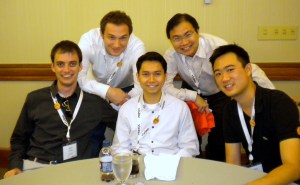“CAL” braving -15°C in the Forbidden City
They say that time waits for no one and it won’t wait for me. What seemed like for long weeks have quickly sped by as I start for my second semester at Haas.
Berkeley, CA
A little known fact: Berkeley has a low-cost, fairly broad student health insurance plan (SHIP). Under SHIP, we not only enjoy $5 copay for eye exams, but also 50% discount on Lasik. Following my last final, I walked across the street from Haas to the UC Berkeley School of Optometry. The next couple days were a bit dark.
Taipei, Taiwan
A week later, got onto a plane and headed to Taiwan. My wife and I got married right before school started and I wanted to take her to Taipei to meet the rest of my family. While in Taipei, I was able to connect with Haas alumni. I was amazed at the loyalty of the alumni that they were willing to go out of their way to meet a stranger. I learned more about what consulting, technology, financial services was like in Taiwan.
Taiwan Alumni dinner with a MBA ’11
Shanghai and Beijing, China
On the 5th, I flew from Taipei to Shanghai to meet up with 59 other Haas MBAs (combination of Full Time and evening/weekend) on a 10 day China Trek. Treks are entirely student run and five of my classmates put together a truly memorable trek.
Balancing company visits, site seeing, and a lot of late night karaoke, it was a tour de force of activities. We got the opportunity to visit companies including: Johnson & Johnson, GM China, Frog Design, Medtronic, Google China, Tencent, Huawei, Innovation Works, and LiNing. Beyond the company visits, we were able to meet up the alumni chapters who were able to provide great insights into doing business in China. One alum stated that there are three rules of doing business in China:
- Everything is possible
- But, everything is hard
- When they say that there it is not a problem, it is a big problem
Over the past four weeks there have simply been to many unforgettable times. It was a privilege to have Kai-Fu Lee (李开复) drop in and discuss his thoughts on China, innovation, and the Chinese psyche. It was incredible to see the passion and love of Haas from the alumni. It was pure bliss to sing “I want it that way” with 59 other classmates.
So what’s next? Study tonight for the waiver exam Friday afternoon, meet up with my wife to attend a SF MOMA 75 Anniversary event in the evening, and meet some prospective Haas ’12 at the Super Saturday I over the weekend.
New Years at Taipei 101 (the 2nd tallest building in the world)
Shanghai at night
—Vince









